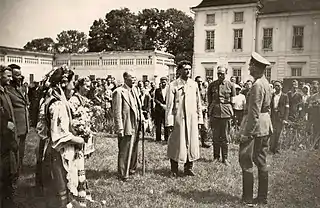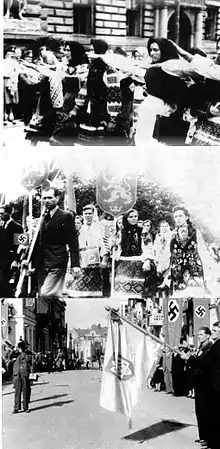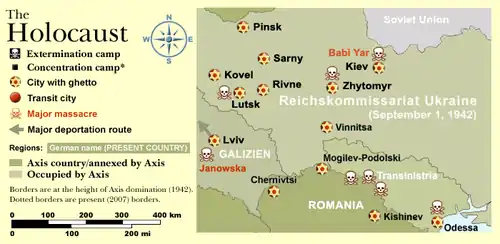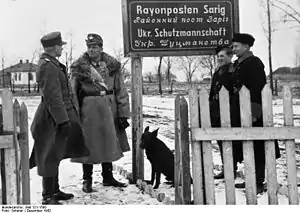Collaboration in German-occupied Ukraine
Collaboration with Nazi Germany in German-occupied Ukraine took place during the military occupation of what is now Ukraine by Nazi Germany in World War II. The new territorial divisions included Distrikt Galizien and Reichskommissariat Ukraine, which covered both, the south-eastern territories of the Second Polish Republic and the Ukrainian Soviet Socialist Republic, across the former borders.
| Collaboration with Nazi Germany | |
|---|---|
| 1941–45 | |
_%D0%B2_%D1%87%D0%B5%D1%81%D1%82%D1%8C_%D0%B2%D0%B8%D0%B7%D0%B8%D1%82%D0%B0_%D0%B3%D0%B5%D0%BD%D0%B5%D1%80%D0%B0%D0%BB-%D0%B3%D1%83%D0%B1%D0%B5%D1%80%D0%BD%D0%B0%D1%82%D0%BE%D1%80%D0%B0_%D0%9F%D0%BE%D0%BB%D1%8C%D1%88%D0%B8_%D1%80%D0%B5%D0%B9%D1%85%D1%81%D0%BB%D1%8F%D0%B9%D1%82%D0%B5%D1%80%D0%B0_%D0%93%D0%B0%D0%BD%D1%81%D0%B0_%D0%A4%D1%80%D0%B0%D0%BD%D0%BA%D0%B0_1.jpeg.webp) Parade in Ivano-Frankivsk in 1943 | |
 Ukrainians greeting arriving Germans in Western Ukraine in the summer of 1941 |
Background
Stalin and Hitler pursued the policy of territorial demands on their immediate neighbour, Poland.[1] The Soviet invasion of Poland brought together Ukrainians of the Soviet Ukraine and the Ukrainians of what was then Eastern Poland (Kresy), under the single Soviet banner. In the territories of Poland invaded by Nazi Germany, the size of Ukrainian minority became negligible and was gathered mostly around UCC (УЦК), formed in Kraków.[2]

Less than two years later, Nazi Germany attacked the Soviet Union. The invasion, known as Operation Barbarossa, began on June 22, 1941, and by September, the occupied territory was divided between two brand new German administrative units, the District of Galicia of the Nazi General Government and the Reichskommissariat Ukraine stretching all the way to Donbas by 1943.[1] Ukrainians who chose to resist and fight German occupation forces joined the Red Army or the irregulars. However, in the newly-annexed portions of western Ukraine there was little to no loyalty towards the Soviet Union, whose Red Army had seized Ukraine during the Soviet invasion of Poland in September 1939. From 1931 to 1933, millions of Ukrainians starved to death in the Holodomor, which was arguably a deliberate attempt at extermination orchestrated by the Soviet government,[3] and from 1937 to 38, thousand members of intelligentsia were exiled, sentenced to gulags or executed.
Reinhard Heydrich noted in a report dated July 9, 1941 that "a fundamental difference between the former Polish and Russian [soviet] territories. In the former Polish region, the soviet regime was seen as enemy rule.... Hence the German troops were greeted by Polish as well as the White Ruthenian population [meaning Ukrainian and Belarussian] for the most part at least as liberators or with friendly neutrality.... The situation in the current occupied White Ruthenian areas of the [pre-1939] USSR has a completely different basis."[4] Actions of German field commanders also indicate a general hostility towards the German in the opening stages of the war, and an order dated August 8, 1941 saw all men between the ages of 18 and 45 rounded up to prevent sabotage.[4]
Occupation
Those Ukrainians who did collaborate with the German occupiers did so in various ways including participating in the local administration, in German-supervised auxiliary police, Schutzmannschaft, in the German military, and serving as concentration camp guards. Nationalists in western Ukraine were among the most enthusiastic and hoped that their efforts would enable them to re-establish an independent state later on. For example, on the eve of Operation' Barbarossa, as many as 4000 Ukrainians, operating under Wehrmacht orders, sought to cause disruption behind Soviet lines. After the capture of Lviv, a highly-contentious and strategically-important city with a significant Ukrainian minority, OUN leaders proclaimed a new Ukrainian State on June 30, 1941 and simultaneously encouraged loyalty to the new regime in the hope that they would be supported by the Germans. Already in 1939, during the German-Polish War, the OUN had been "a faithful German auxiliary".[5]
Professor Ivan Katchanovski writes that during the war, the leadership of OUN B and UPA was heavily engaged in Nazi collaboration. He wrote that at least 23% of its leaders in Ukraine were in the auxiliary police, Schutzmannschaft Battalion 201, as well as in other police formations, and 18% took part in training in Nazi Germany's military and intelligence schools in Germany and Nazi-occupied Poland, 11% served the Nachtigall and Roland Battalions, 8% in local administration during the Nazi occupation and 1% in the SS Galicia Division. According to Katchanovski, the percentage of Nazi collaborators among the OUN-B and UPA leadership is likely higher than those numbers since data from early occupation are often missing.[6]
Despite initially acting warmly to the idea of an independent Ukraine, the Nazi administration had other ideas, particularly the Lebensraum programme and the total 'Aryanisation' of the population. It preferred to play the Slavic nations against one another. OUN initially carried out attacks on Polish villages to try to exterminate Polish populations or expel Polish enclaves from what the OUN fighters perceived as Ukrainian territory.[5] When OUN help was no longer needed, its leaders were imprisoned, and many members were summarily executed. The arrests were only temporary, however, according to professor Katchanovski since 27% of the leadership of OUN B and UPA were arrested at least once, they were released relatively soon or allowed to escape.[7]
According to Timothy Snyder, "something that is never said, because it's inconvenient for precisely everyone, is that more Ukrainian Communists collaborated with the Germans, than did Ukrainian nationalists." Snyder also points out that very many of those who collaborated with the German occupation also collaborated with the Soviet policies in the 1930s.[8]
The Holocaust
Operation Barbarossa in 1941 brought together native Ukrainians of the Soviet Ukraine and the prewar territories of Poland annexed by the Soviet Union as well. To the north-east, they fell under the German administrative control of Reichskommissariat Ukraine and, to the south-west, under the Nazi General Government. The Ukrainian Insurgent Army (UPA) volunteered to assist the Wehrmacht.[1] In total, the Germans enlisted 250,000 native Ukrainians for duty in five separate formations including the Nationalist Military Detachments (VVN), the Brotherhoods of Ukrainian Nationalists (DUN), the Galician Division of the Waffen SS, the Ukrainian Liberation Army (UVV) and the Ukrainian National Army (Ukrainische Nationalarmee, UNA).[1][9] By the end of 1942, in Reichskommissariat Ukraine alone, the SS employed 238,000 Ukrainians and only 15,000 Germans, a ratio of 1 to 16.[10]

The atrocities against Jews during the Holocaust in Ukraine started within a few days of the beginning of the Nazi occupation. There are indications that the Ukrainian Auxiliary Police, formed on 20 August 1941,[11] was used in the roundup of Jews for the Babi Yar massacre,[12][13] and in other massacres in cities and towns of modern-day Ukraine, such as Stepan,[14] Lviv, Lutsk, and Zhytomyr.[15] On 1 September 1941, Nazi-sponsored Ukrainian newspaper Volhyn wrote: "The element that settled our cities (Jews)... must disappear completely from our cities. The Jewish problem is already in the process of being solved."[16]
Reinforced by religious prejudice, anti-Semitism had turned violent in the first days of the German attack on the Soviet Union. Some Ukrainians derived nationalist resentment from the belief that the Jews had worked for Polish landlords.[17] The NKVD prisoner massacres by the Soviet secret police while they retreated eastward were blamed on Jews. The Antisemitic canard of Jewish Bolshevism provided justification for the revenge killings by the ultranationalist Ukrainian People's Militia, which accompanied German Einsatzgruppen moving east.[17] In Boryslav (prewar Borysław, Poland, population 41,500), the SS commander gave an enraged crowd, which had seen bodies of men murdered by NKVD and laid out in the town square, 24 hours to act as they wished against Polish Jews, who were forced to clean the dead bodies and to dance and then were killed by beating with axes, pipes etc. The same type of mass murders took place in Brzezany. During Lviv pogroms, 7,000 Jews were murdered by Ukrainian nationalists, led by the Ukrainian People's Militia.[17][18][19] As late as 1945, Ukrainian militants were still rounding up and murdering Jews.[20]
While some of the collaborators were civilians, others were given a choice to enlist for paramilitary service beginning in September 1941 from the Soviet prisoner-of-war camps because of ongoing close relations with the Ukrainian Hilfsverwaltung.[21] In total, over 5,000 native Ukrainian soldiers of the Red Army signed up for training with the SS at a special Trawniki training camp to assist with the Final Solution.[22] Another 1,000 of them defected during field operations.[22] Trawniki men took major part in the Nazi plan to exterminate European Jews during Operation Reinhard. They served at all extermination camps and played an important role in the annihilation of the Warsaw Ghetto Uprising (see the Stroop Report) and the Białystok Ghetto Uprising among other ghetto insurgencies.[23] The men who were dispatched to death camps and Jewish ghettos as guards were never fully trusted and so were always overseen by Volksdeutsche.[24] Occasionally, along with the prisoners they were guarding, they would kill their commanders in the process of attempting to defect.[25][26]
In May 2006, the Ukrainian newspaper Ukraine Christian News commented, "Carrying out the massacre was the Einsatzgruppe C, supported by members of a Waffen-SS battalion and units of the Ukrainian auxiliary police, under the general command of Friedrich Jeckeln. The participation of Ukrainian collaborators in these events, now documented and proven, is a matter of painful public debate in Ukraine".[27]
Collaborationist organizations, political movements, individuals and military volunteers
Auxiliary police

109, 114, 115, 116, 117, 118, 201-st Ukrainian Schutzmannschaftant-battalions participated in anti-partisan operations in Ukraine and Belarus. In February and March 1943, the 50th Ukrainian Schutzmannschaftant-battalion participated in the large anti-guerrilla action «Operation Winterzauber» (Winter magic) in Belarus, cooperating with several Latvian and the 2nd Lithuanian battalion. Schuma-battalions burned down villages suspected of supporting Soviet partisans.[28] On March 22, 1943, all inhabitants of the village of Khatyn in Belarus were burnt alive by the Nazis in what became known as the Khatyn massacre, with participation of the 118th Schutzmannschaft battalion.[29][30]
Ukrainian volunteers in the German armed forces
- Nachtigall Battalion
- Roland Battalion
- Freiwilligen-Stamm-Regiment 3 & 4 (Russians & Ukrainians)
- Ostlegionen
- Hiwi
SS Division "Galizien"
On 28 April 1943 the German Governor of District Galicia, Otto Wächter, and the local Ukrainian administration officially declared the creation of the SS Division Galicia. Volunteers signed for service as of 3 June 1943 and numbered 80,000.[31] On 27 July 1944 the Galizien division was formed into the Waffen-SS as 14. Waffen-Grenadier-Division der SS (gal. Nr. 1).[32]
The prevailing belief is that these men eagerly volunteered to take part in a patriotic war against the Soviets, not because of any support for Nazi Germany.[33] Also, at least some of them were victims of compulsory conscription, since Germany had now suffered defeats and lost manpower on the eastern front.[34] Sol Litman of the Simon Wiesenthal Center state that there are many proven and documented incidents of atrocities and massacres committed by the Waffen-SS Galizien against minorities, particularly Jews during World War II.[35] However other authors, including Michael Melnyk,[34] and Michael O. Logusz,[36] maintain that members of the division served almost entirely on the front lines against the Red Army and defend the unit against the accusations made by Litman and others. Official SS records show that the 4,5,6 and 7 SS-Freiwilligen regiments were under Ordnungspolizei command during the accusations.[32][37] (See 14th Waffen Grenadier Division of the SS (1st Ukrainian)#Accusations of war atrocities).
Ukraine propaganda news
- Ukrainskyi Dobrovoletz (Der ukrainische Kämpfer) - Ukrainische Freiwilligenverbände
Ukrainian units in the German work organization
- Organization Todt OT-Einsatzgruppe Ost (Kiev)
Ukrainian National Committee
In March 1945, the Ukrainian National Committee was set up after a series of negotiations with the Germans. The Committee represented and had command over all Ukrainian units fighting for the Third Reich, such as the Ukrainian National Army. However, it was too late, and the committee and the army were disbanded at the end of the war.
Heads of local Ukrainian administration and public figures under the German occupation
- Oleksander Ohloblyn (Kiev mayor, 1941)
- Volodymyr Bahaziy (Kiev mayor, 1941–1942, executed by Germans in 1942)
- Leontii Forostivsky (Kiev mayor, 1942–1943)
- Mykola Velychkivsky (head of the Ukrainian National Committee in Kiev, dismissed in 1942, later emigrated)
- Fedir Bohatyrchuk (head of the Ukrainian Red Cross, 1941–1942)
- Oleksii Kramarenko (Kharkiv mayor, 1941–1942, executed by Germans in 1943)
- Oleksander Semenenko (Kharkiv mayor, 1942–1943)
- Paul Kozakevich (Kharkiv mayor, 1943)
- Aleksandr Sevastianov (Vinnytsia mayor, 1941 – ?)
Notes
- Alfred J. Rieber (2003). "Civil Wars in the Soviet Union" (PDF). 4/1. Project Muse: 133, 145–147. Cite journal requires
|journal=(help) Slavica Publishers. - Tadeusz Piotrowski (1997). "1. Soviet terror". Poland's Holocaust: Ethnic Strife, Collaboration with Occupying Forces and Genocide in the Second Republic, 1918-1947. McFarland. pp. 11–12. ISBN 978-0786429134.
- Tauger, Mark (Spring 1991). "The 1932 Harvest and the Famine of 1933". Slavic Review. 50 (1): 70–89. doi:10.2307/2500600. JSTOR 2500600.
- Thurston, Robert (1996). Life and Terror in Stalin's Russia, 1934-1941.
- John A. Armstrong, Collaborationism in World War II: The Integral Nationalist Variant in Eastern Europe, The Journal of Modern History, Vol. 40, No. 3 (Sep., 1968), p. 409.
- Ivan Katchanovski, Ph.D. (2010), Terrorists or National Heroes? Politics of the OUN and the UPA in Ukraine. PDF file, direct download.
- Katchanovski 2010, page 9.
- Germans must remember the truth about Ukraine – for their own sake, Eurozine (7 July 2017)
- Motyka, Grzegorz (February 2001). "Dywizja SS 'Galizien'" [SS Division 'Galicia']. Pamięć I Sprawiedliwość (in Polish). Biuletyn IPN. 1. Archived from the original on 3 January 2003.CS1 maint: unfit URL (link)
- Jeffrey Burds (2013). Holocaust in Rovno: The Massacre at Sosenki Forest, November 1941. Springer. pp. 24–25. ISBN 978-1137388407.
- Jürgen Matthäus (18 April 2013). Jewish Responses to Persecution: 1941–1942. AltaMira Press. p. 524. ISBN 978-0759122598.
- Spector, Shmuel (1990). "Extracts from the Babi Yar article". In Israel Gutman, editor in Chief (ed.). Encyclopedia of the Holocaust. Yad Vashem, Sifriat Hapoalim, Macmillan Publishing Company. Archived from the original on 30 December 2012.
The implementation of the decision to kill all the Jews of Kiev was entrusted to Sonderkommando 4a. The unit consisted of SD men (Sicherheitsdienst; Security Service) and Sicherheitspolizei (Security Police; Sipo); the third company of the Special Duties Waffen-SS battalion; and a platoon of the No. 9 police battalion. The unit was reinforced by police battalions Nos. 45 and 305 and by units of the Ukrainian auxiliary police.
CS1 maint: unfit URL (link) - "It took nerves of steel: Statement of Truck-Driver Hofer Describing the Murder of Jews at Babi Yar". The Einsatzgruppen Archives. 1997. Archived from the original on 18 December 2007.
The Ukrainians led them past a number of different places where one after the other they had to remove their luggage, then their coats, shoes and overgarments and also underwear. They also had to leave their valuables in a designated place. There was a special pile for each article of clothing. It all happened very quickly and anyone who hesitated was kicked or pushed by the Ukrainians to keep them moving.
CS1 maint: unfit URL (link) - Ganuz, I.; Peri, J. (28 May 2006). "The Generations of Stepan: The History of Stepan and Its Jewish Population". jewishgen.org. Retrieved 25 May 2016.
- "The Holocaust Timeline: 1941 - July 25 Pogrom in Lvov/June 30 Germany occupies Lvov; 4,000 Jews killed by July 3/June 30 Einsatzkommando 4a and local Ukrainians kill 300 Jews in Lutsk/September 19 Zhitomir Ghetto liquidated; 10,000 killed". yadvashem.org. Retrieved 26 May 2016.
- "The Holocaust September 1, 1941: Ukraine". NAAF On-line Holocaust Project. Archived from the original on 24 January 2012.
- Richard J. Evans (2009). The Third Reich at War: 1939-1945. London: Penguin Books. pp. 203–223. ISBN 978-1101022306.
- Jakob Weiss, Lemberg Mosaic, p. 173. ISBN 0983109117.
- Lucy S. Dawidowicz (1975), The War Against the Jews 1933-1945, Bantam Books Inc., New York, p. 171.
- The Holocaust Chronicle, A History in Words and Pictures, Edited by David J. Hogan, Publications International Ltd, Lincolnwood, Illinois, p.592
- Markus Eikel (2013). "The local administration under German occupation in central and eastern Ukraine, 1941–1944". The Holocaust in Ukraine: New Sources and Perspectives (PDF). Center for Advanced Holocaust Studies, United States Holocaust Memorial Museum. 110–122 in PDF.
Ukraine differs from other parts of the Nazi-occupied Soviet Union, whereas the local administrators have formed the Hilfsverwaltung in support of extermination policies in 1941 and 1942, and in providing assistance for the deportations to camps in Germany, mainly in 1942 and 1943.
- David Bankir, ed. (2006). Police Auxiliaries for Operation Reinhard by Peter R. Black. Secret Intelligence and the Holocaust. Enigma Books. pp. 331–348. ISBN 192963160X – via Google Books.CS1 maint: extra text: authors list (link)
- Yitzhak Arad (1987). Belzec, Sobibor, Treblinka: The Operation Reinhard Death Camps. Indiana University Press. p. 21. ISBN 0253342937.
- Gregory Procknow (2011). Recruiting and Training Genocidal Soldiers. Francis & Bernard Publishing. p. 35. ISBN 978-0986837401.
- Himka, John-Paul (1998). "Ukrainian Collaboration in the Extermination of the Jews During World War II: Sorting out the Long-Term and Conjunctural Factors". In Jonathan Frankel (ed.). Studies in Contemporary Jewry: Volume XIII: The Fate of the European Jews, 1939-1945: Continuity or Contingency?. XIII. Oxford University Press. pp. 170–190. ISBN 978-0-19-511931-2. Archived from the original on January 6, 2012.
- "Belzec: Stepping Stone to Genocide, Chapter 4 – cont". JewishGen, Inc. February 13, 2008. Retrieved May 7, 2016.
- Holocaust Victims Honored in Babi Yar (Ukraine Christian News, May 3, 2006) Accessed January 14, 2006
- Gerlach, C. «Kalkulierte Morde» Hamburger Edition, Hamburg, 1999
- State Memorial Complex "Khatyn" official web-page http://khatyn.by/en/genocide/expeditions/ - The destruction of the village of Khatyn is a tragic and vivid example. The village was annihilated by the thugs from the 118th Police Battalion, which was stationed in a small town of Pleschinitsy, and by the thugs from the SS battalion "Dirlewanger", which was stationed in Logoisk.
- В.И. Адамушко "Хатынь. Трагедия и память НАРБ 2009 ISBN 978-985-6372-62-2
- K.G. Klietmann Die Waffen SS; eine Dokumentation Osnabruck Der Freiwillige, 1965 p.194
- GEORG TESSIN Verbande und Truppen der deutschen Wehrmacht und Waffen SS im Zweiten Weltkrieg 1939-1945 DRITTER BAND: Die Landstreitkrafte 6—14 VERLAG E. S. MITTLER & SOHN GMBH. • FRANKFURT/MAIN ISBN 3-7648-0942-6 page 313
- Williamson, G: The SS: Hitler's Instrument of Terror
- Melnyk, Michael. To Battle: The Formation and History of the 14. Gallician SS Volunteer Division. Helion and Company Ltd.
- Litman, Sol (2003). Pure Soldiers or Bloodthirsty Murderers?: The Ukrainian 14th Waffen-SS Galicia Division (Hardcover ed.). Black Rose Books. ISBN 1-55164-219-0.
- Logusz, Michael. Galicia Division: The Waffen-SS 14th grenadier Division 1943-1945. Schiffer Publishing.
- Tessin, Georg / Kannapin, Norbert. Waffen-SS und Ordnungspolizei im Kriegseinsatz 1939-1945.ISBN 3-7648-2471-9 p.52.
References
- Gilbert Martin (1987). The Holocaust: A History of the Jews of Europe During the Second World War (Reprint ed.). Owl Books. ISBN 978-0-8050-0348-2.
- Gilbert Martin (1986). The Holocaust: The Jewish tragedy (Unknown Binding ed.). Collins. ISBN 978-0-00-216305-7.
- Collaborationism in World War II: The Integral Nationalist Variant in Eastern Europe, by John A. Armstrong in The Journal of Modern History > Vol. 40, No. 3 (Sep., 1968), pp. 396–410
- Mordecai Paldiel (1993). The Path of the Righteous: Gentile Rescuers of Jews During the Holocaust. KTAV Publishing House in association with the ADL. ISBN 0-88125-376-6.
- Mordecai Paldiel and Elie Wiesel (2007). The Righteous Among the Nations: Rescuers of Jews During the Holocaust. HarperCollins Publishers. ISBN 978-0-06-115112-5.